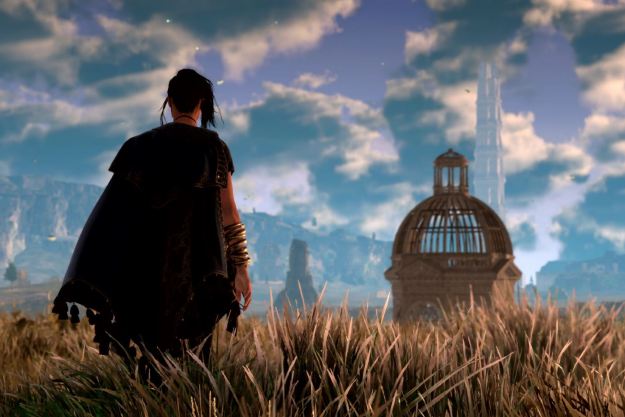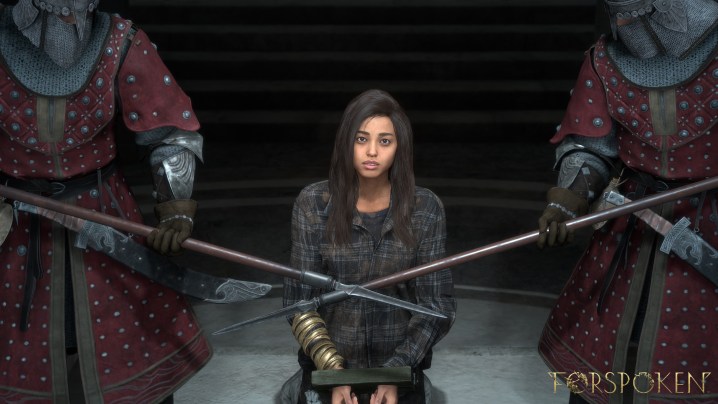
“Forspoken takes too long to get started due to a poorly paced story, but its dazzling spellcasting and parkour traversal will reward patient players.”
- Athia is worth exploring
- Strong lead performance
- Rewarding open-world design
- Intense magic combat
- Slow start
- Struggles to connect story and gameplay
- Controls are not newcomer-friendly
As I blasted a machine gun-like flurry of rocks toward a swarm of enemies I had frozen with another one of my magical abilities, I began to understand just how enthralling Forspoken could be. Square Enix’s new action-adventure game dazzles once it gives players free reign to parkour around its open world and sling spells. Unfortunately, it takes a while to get to that point, and even once it does, it struggles to remain focused on it.
Forspoken is the first major AAA release of the year and the latest PlayStation 5 console exclusive, so all eyes are on it to deliver. Once players have some time to get comfortable with the controls, running around the vast and well-designed open world of Athia is equally adventurous and exhilarating, with combat acting as a visual spectacle that rewards mastery of its systems. Forspoken’s story is much less consistent, though, with an excellent lead performance and notable twists that are sullied by poor pacing and delivery.
Forspoken is magical when focusing on its strengths, but it’ll take some crawling to get through a slow opening. Long-winded story interludes also fail to emphasize what the game does best. Those flaws hold it back from becoming the next great open-world game, but fantasy fans should find plenty to enjoy as they dash through a vast world as a powerful sorceress.
Narrative disconnect
Forspoken follows Alfrey Holland, who goes by Frey, a troubled 21-year-old orphan whisked away to a magical world called Athia (Alice in Wonderland-style) on Christmas Day. She wakes up with a sarcastic magic cuff strapped to her arm that helps guide her. Soon, Frey discovers that a deadly force called the Break is plaguing Athia after the Tantas, the four ruling women of this world, went insane. Initially, Frey doesn’t want to deal with any of this and only wants to find her way back to New York, but she is pulled into an adventure to save the world by Cuff and other friends she makes in Athia.
Fun stretches of action are distributed between lengthy narrative-focused spurts, leaving a disconnect between the two.
The narrative’s broad strokes generally work, as it has fun showing players its world through the eyes of a woman who constantly refuses the call to adventure and critiques RPG tropes that we typically overlook, like its protagonists murdering people for personal gain. It’s fun to see Japanese-style AAA game sensibilities, not unlike the ones you’d find in developer Luminous Productions’ Final Fantasy XV, applied to a thoroughly Western fantasy world. Unfortunately, this story never fully comes together for a few reasons.
It’s heartening to see a non-white protagonist in a major video game, and Luminous does try to pair that with a racial allegory about a character who feels belittled and out of place in Athia at first. But Forspoken isn’t very interested in engaging with those ideas as anything more than backstory and narrative window dressing (Frey has a loaded history, complete with an arrest record, but it’s little more than an early game readable). The plot that is there isn’t gracefully delivered either. The first several hours of this 20-hour adventure are mainly narrative-focused, deemphasizing gameplay and frontloading the experience with lots of character backstories, lore, and jargon that doesn’t make a lot of sense the first time you hear it.

With a frontloaded story and controls that take a bit of practice to get used to, Forspoken’s earliest hours are its worst. Successful open-world games like Elden Ring understand that the faster you get players into the sandbox, the better. Forspoken never feels like it’s in a rush to do that, instead making this new IP feel more overwhelming than inviting. A narrative twist near the end also adds some intriguing depth to the adventure, making me want to see the game through. But it never goes through the effort to fuse story and gameplay together that well. Instead, fun stretches of action are distributed between lengthy narrative-focused spurts, leaving a disconnect between the two.
Thankfully, the narrative shortcomings are backed up by a strong performance from Ella Balinska. While movie actors making the jump to video games often comes with mixed results, Ella’s passion for Frey comes through in some of the game’s extended monologues, even when they’re full of jargon. Sadly, I usually wanted to jump through the rabbit hole to return to the fun, open-world gameplay in those moments.
Forspoken has that open-world magic
The narrative segments of Forspoken, which often take place in the city of Cipal, don’t do much to highlight the game’s biggest strengths: its combat and exploration. Still, players will discover a delightful open-world romp once the game opens up several hours in. Athia is beautiful when playing in both Quality or Performance mode, with stark rock formations serving as intimidating backdrops to various biomes and landscapes, from deserts to open fields to mountains that seem to be falling apart.

Exploring those areas is a lot of fun too. By simply holding down the Circle button, players can “Flow” to run fast around Athia and even parkour over more objects. Over time, players will unlock the ability to grapple and even surf across the water, as the player’s methods of exploration and access to areas to explore continuously expand. The momentum feels weighty but satisfyingly substantial while galloping around Athia, and that only gets more and more fun as the game goes on.
While out in Athia, players will come across ruins of villages and fortresses that existed before the Break: monuments that give stat boosts, Pilgrim’s Refuges where Frey can rest, craft, and upgrade her gear, and more. No matter what players decide to do in the open world, the game will reward them with something useful. There’s always somewhere new to visit to find new cloaks, necklaces, or nails (and the customizable buffs that come with them), as well as engrossing lore archive entries or general stat boosts. Even if you’re not heading towards a specific objective, you’ll find mana to upgrade Frey’s abilities and chests with items for crafting scattered around Athia.
I was always looking for the most successful ways to combo my parkour and magical abilities by the end.
Players aren’t just rewarded by uncovering the map, but they’ll gain power as they explore, collect, and craft. While doing this, Frey encounters a wide variety of enemies infected by the Break and must take them down with magic, which makes for a visual spectacle on the PS5. She starts with rock- and plant-based skills, but gains access to fire-, wate-r, and energy-based magic as the story progresses. Magic is split into Attack and Support types, and players must juggle them effectively to succeed.
By the end of Forspoken, players will gain access to four different types of magic, each of which has three primary types of Attack spells and eight kinds of Support spells to unlock. Each spell works differently, but fits general archetypes. For example, Frey’s rock- and plant-based abilities are great for fighting enemies from a range, but fire-based magic will become much more helpful later in head-on encounters. Parkour also plays a part in combat, as players will successfully dodge attacks while utilizing Flow, and can even combo it into more powerful types of magic.

As the game progresses, Frey’s stats get better, Spells are upgraded by completing side challenges, and combat gets more intense. Players are not just rewarded with a visual spectacle for their spellcasting, but they’ll do a lot more damage as well. Still, it took me several hours to get to that point with Forspoken, as there’s not a lot of combat early on, and the controls feel cumbersome at first. Holding Circle to run while using all of the triggers and bumpers on the controller to use magic stretched the DualSense (and my hands) to their limits. It took me a couple of hours of exploration to get used to it, but I was always looking for the most successful ways to combo my parkour and magical abilities by the end.
Give it time
That initial learning curve only underlines Forspoken’s sluggish introduction further. Losing those magical abilities when I returned to Cipal made me wish I was back in the open world. Forspoken simply isn’t playing to its strengths by taking this approach. In fact, there are entire large sectors of this world that the main story never requires players to venture through at all; most of the story unfolds in one city, leaving swaths of the map feeling like blank space.

Forspoken does know how to do open-world game design right: there’s always somewhere interesting to go, it’s fun to get there, and you’ll always be rewarded for engaging. That’s why it’s such a drag that it takes so long to get to that gameplay loop and that players are occasionally corralled back into more linear sections so the story can progress.
I would recommend Forspoken to action and RPG fans, but I wish I could give them one of my save files with total open-world freedom and most of the traversal and combat spells unlocked from the jump. The adventure is at its weakest when it’s forcing players to wade through lots of poor narrative content that takes too long to pay off. Its best beats aren’t paced or delivered well and serve as a weighty vambrace holding back this game’s real magic: a dazzling open-world game that truly does feel next-gen.
Digital Trends reviewed Forspoken on PS5. It will also be released for PC on January 24.
Editors' Recommendations
- PS5 themes: Can you customize your homescreen?
- Final Fantasy 16: release date, trailers, gameplay, and more
- The best upcoming PS5 games: 2023 and beyond
- The best video game consoles for 2023
- Mario Kart Live: Home Circuit’s studio has made an AR Hot Wheels game




